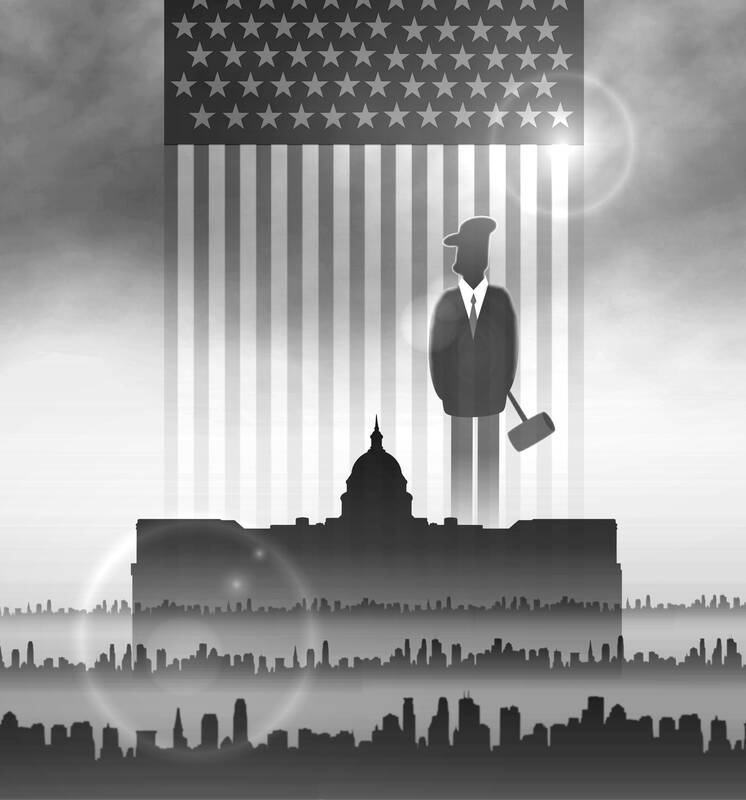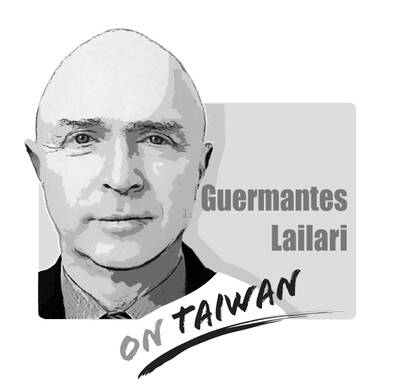Does US President Donald Trump have a master plan for a new world order? On the face of it, he goes mainly by instinct and does not seem like much of a planner. On the other hand, he has just won a second term in the White House — that takes planning — and he arrived with a bold and wide-ranging agenda. If he has an encompassing geopolitical ambition, it would be prudent to take it seriously.
Required reading on this is an essay by Stephen Miran, a credentialed economist, asset manager and fellow of the Manhattan Institute, whom the president has nominated to chair the Council of Economic Advisers. In “A User’s Guide to Restructuring the Global Trading System,” Miran considers the options for “generational change in the international trade and financial systems.”
Miran insists he is not necessarily recommending the initiatives he discusses.

Illustration: Yusha
“This essay is not policy advocacy,” he writes.
Sure, whatever. The point is that the policies he is not necessarily advocating would indeed add up to a fundamental geopolitical restructuring —— one that is coherent, thought through, mostly consistent with orthodox economic principles, and remarkably reckless.
The essential starting points are authentically Trumpian. First, the world is ripping off the US. Second, to put this right, trade and industrial policy, monetary policy, and foreign and security policy must be seen as all one and made to work together.
According to Miran, the main economic channel through which other nations victimize the US is their use of the dollar as a reserve currency.
Economists typically see reserve-currency status as a good thing for the US — even an exorbitant privilege. Miran allows that demand for the dollar as a reserve currency might benefit the US through (slightly) lower interest rates. It also enables the US to project power by using the international financial system to impose sanctions. However, it also causes a chronically overvalued currency, which boosts imports, depresses exports, throttles domestic manufacturing and causes a persistent trade deficit.
Hence the task at hand: Lower the value of the dollar while avoiding collateral damage. Damage to the US, that is.
Note that the president wants to retain the dollar’s reserve-currency status. Aside from losing its just-noted benefits, dethroning the currency would not sit well with making America great again. (Trump has threatened to punish countries that stop using the dollar in their payment systems.) However, pushing the dollar lower is also essential. Miran explains how the US can achieve both goals by bringing to bear other elements of US power. Miran calls this “burden sharing” — his term for taking burdens away from the US and placing them on other countries.
Tariffs have a leading role to play in this scheme — and it is not their usual role. The conventional view is that tariffs are mostly self-defeating when it comes to reducing trade imbalances, partly because they cause the currency to appreciate (making imports cheaper and exports more expensive) and partly because they lead trade partners to retaliate with their own tariffs. You end up with less total trade, but roughly the same trade deficit you started with — not to mention diminished competition and slower growth in productivity.
The Trump world order sees things differently. First, the US can use tariffs more successfully than other countries because of the size of its market. This gives it monopsony power — so foreign suppliers are forced to lower their prices in response. If the US is willing to exploit its economic weight, it can make itself better off at trading partners’ expense. On this view, the so-called optimal tariff might be about 20 percent, as opposed to the current average US tariff of 3 percent.
This argument fails if trading partners retaliate — but they would not retaliate if other threats are deployed. Tariffs, actual or threatened, are not just a way to protect US producers and raise revenue, but also a way to force trading partners to make concessions on their own tariffs, and across a wide span of other economic and security matters.
“One can imagine a long list of trade and security criteria which might lead to higher or lower tariffs, premised on the notion that access to the US consumer market is a privilege that must be earned, not a right,” Miran writes.
Examples drawn from a long list of such criteria include: excessive accumulation of dollar reserves; failing to pay NATO obligations in full; taking the side of US adversaries in “key international disputes”; and choosing to “grandstand against the US in the international theater.”
Miran also discusses the options for financial policies. Here, too, the US might pressure other countries to go along with the greenback’s depreciation — in this case, by selling some of their dollar reserves and changing the composition of the remaining holdings from short to long-term US dollar debt. This combination might plausibly lower the dollar while (a) limiting the increase in long-term dollar interest rates that would otherwise result and (b) shifting interest-rate risk from US taxpayers to foreign taxpayers. As before, the key is to make credible threats.
“How can the US get trading and security partners to agree to such a deal?” Miran asks. “First, there is the stick of tariffs. Second, there is the carrot of the defense umbrella and the risk of losing it.”
There are many further complications — not least for the US Federal Reserve. Miran frequently acknowledges the risks of financial volatility as such a vision unfolds. Managing that risk would demand cautious methodical steps, he writes. (US Secretary of the Treasury Scott Bessent has discussed the case for imposing a schedule of slow and steady tariff increases rather than huge increases all at once.) If financial markets decided to melt down anyway, the central bank would need to step up with large-scale liquidity operations. The Fed would also need to cooperate with a cheap-dollar policy by refraining from raising the policy rate if depreciation pushed up inflation. The possible threat to the Fed’s perceived independence is obvious — which adds in its own right to the danger of financial disarray.
Summing up, the world according to Trump is not so much a restructuring of global trade as a wholesale destructuring of the geopolitical order. US-led cooperation in pursuit of multilateral benefit gives way to US coercion, of friends and enemies alike, in pursuit of unilateral gain. Henceforth, allies are subordinates to be pushed around: They must take a knee and earn their privilege.
It would be wrong to call this prospectus incoherent. It kind of adds up. And, as is often the case, Trump’s ideas start from germs of truth. Europe’s failure to pull its weight on defense is a legitimate US complaint. Reserve-currency status has drawbacks as well as advantages, and so forth. As always, though, the particles of validity in Trump’s thinking are embedded in a reckless, hyperbolic repudiation of the status quo and a policy program that courts enormous risk. The Trump world order could be a disaster in the making.
Clive Crook is a Bloomberg Opinion columnist and member of the editorial board covering economics. Previously, he was deputy editor of The Economist and chief Washington commentator for the Financial Times. This column does not necessarily reflect the opinion of the editorial board or Bloomberg LP and its owners.
Congratulations to China’s working class — they have officially entered the “Livestock Feed 2.0” era. While others are still researching how to achieve healthy and balanced diets, China has already evolved to the point where it does not matter whether you are actually eating food, as long as you can swallow it. There is no need for cooking, chewing or making decisions — just tear open a package, add some hot water and in a short three minutes you have something that can keep you alive for at least another six hours. This is not science fiction — it is reality.

A foreign colleague of mine asked me recently, “What is a safe distance from potential People’s Liberation Army (PLA) Rocket Force’s (PLARF) Taiwan targets?” This article will answer this question and help people living in Taiwan have a deeper understanding of the threat. Why is it important to understand PLA/PLARF targeting strategy? According to RAND analysis, the PLA’s “systems destruction warfare” focuses on crippling an adversary’s operational system by targeting its networks, especially leadership, command and control (C2) nodes, sensors, and information hubs. Admiral Samuel Paparo, commander of US Indo-Pacific Command, noted in his 15 May 2025 Sedona Forum keynote speech that, as
In a world increasingly defined by unpredictability, two actors stand out as islands of stability: Europe and Taiwan. One, a sprawling union of democracies, but under immense pressure, grappling with a geopolitical reality it was not originally designed for. The other, a vibrant, resilient democracy thriving as a technological global leader, but living under a growing existential threat. In response to rising uncertainties, they are both seeking resilience and learning to better position themselves. It is now time they recognize each other not just as partners of convenience, but as strategic and indispensable lifelines. The US, long seen as the anchor
Kinmen County’s political geography is provocative in and of itself. A pair of islets running up abreast the Chinese mainland, just 20 minutes by ferry from the Chinese city of Xiamen, Kinmen remains under the Taiwanese government’s control, after China’s failed invasion attempt in 1949. The provocative nature of Kinmen’s existence, along with the Matsu Islands off the coast of China’s Fuzhou City, has led to no shortage of outrageous takes and analyses in foreign media either fearmongering of a Chinese invasion or using these accidents of history to somehow understand Taiwan. Every few months a foreign reporter goes to